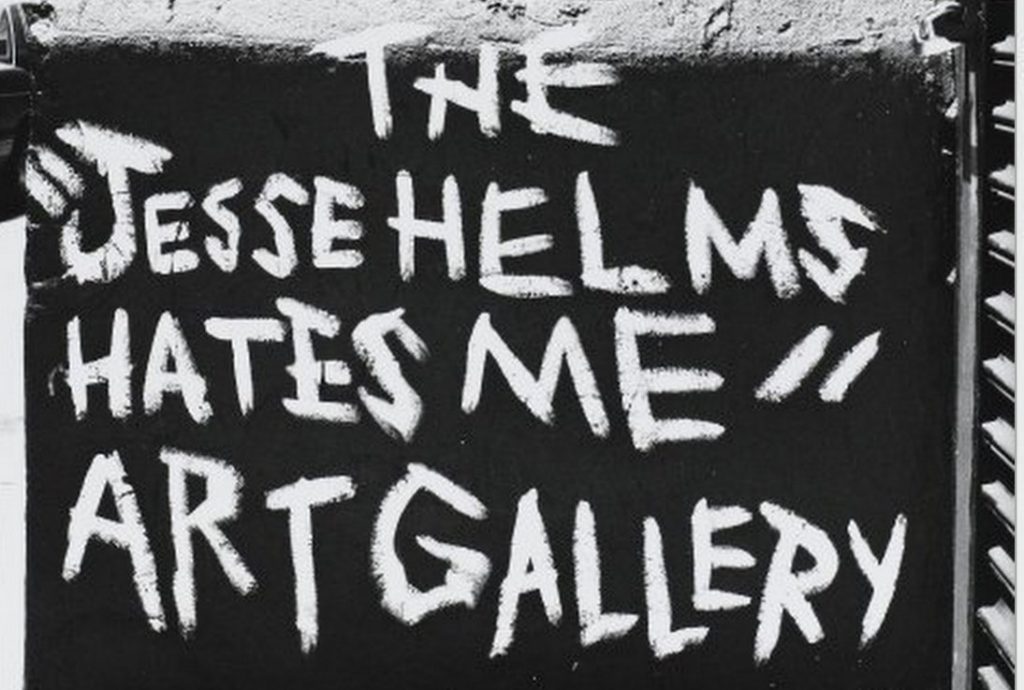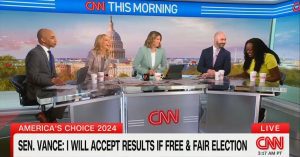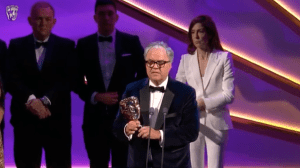In 1989 Jesse Helms, the contentious and controversial conservative senator from North Carolina, launched an attack on the National Endowment for the Arts for its support of shows that included work which he deemed offensive. Ten years later as Mayor of New York, Rudy Giuliani engaged in a similar attack, threatening to cut off the city’s support of the Brooklyn Museum because of its show “Sensation” which featured Chris Offili’s painting “The Holy Virgin Mary”, a depiction of of the Blessed Mother emblazoned with elephant dung.
These two controversies have come to frame the perception of conservative opposition to public funding for the arts. It is viewed as a battle between liberals who value free speech and broad access to the arts and conservatives who want to censor art and cut funding to those institutions that bring art to the people. It is a battle that conservatives have been soundly losing. It is the wrong battle. The better argument against the current model of federal arts spending is much more simple, and much closer to the heart of the conservative movement. What conservatives should be saying is that the NEA and the tax exempt status of many arts organizations are hurting the very art forms they purport to support. They are in fact making American art less relevant to American’s lives.
I have been a theater actor and producer in New York for over a decade. In that time I have seen many talented kids coming out of school who want to form theater companies . Their first concern is not finding an audience, its finding a grant, or finding wealthy donors. In fact this is what they are taught to do at universities all across the country. The basic assumption is that theater cannot survive in the marketplace. That without federal, state and city dollars it will cease to exist. The fact that theater is about as old as human civilization and has existed under every governmental system known to man (including many which actively tried to suppress it) doesn’t seem to enter into this analysis. It is simply accepted that government support of the arts creates better, and better attended art. In fact, the perverse market incentives enshrined by federal tax expenditures through deductions for arts giving and direct government support have been accompanied by a decrease in attendance and a crisis in theater. There are three compelling reasons why we need to reexamine the role of government in the arts, and specifically in theater. First and most importantly it is failing. Less and less people go to theater even though the federal dollars keep rolling in. Second, these government dollars are not expanding the base of arts attendees, but rather subsidizing the entertainment of wealthy, white people. Thirdly, government dollars are not content neutral, a cultural ground game is being executed by the progressive Non Profit community to ensure that culture remains the sole preserve of leftist ideology.
We built it, they aren’t coming
In a 2009 speech Rocco Landesman, then head of the NEA, invoked the movie “Field of Dreams” to argue that if the government continued its support of flailing theater companies then the audiences would be there. “If you build it they will come.” I don’t know if Landesman received this revelation from a spooky voice in a Iowa cornfield, or from acolytes in the theater community. In any event the facts run counter to his assertion. According to the NEAs own numbers the percentage of Americans who attended theater dropped by thirty percent from 1992 to 2008. In that time the number of 501 (c) 3 tax exempt theaters doubled, from about 900 to about 1800. The total number of tax payer dollars dedicated to those companies also increased. So more companies are getting more money to create theater but less people are attending.
To make matters worse, the same NEA report tells us that only the most expensive tickets showed significant growth in sales over the past 20 years. It’s not rare for major non profit institutions like Roundabout Theater Company or the Atlantic Theater Company to charge 70 dollars or more to see a show. A family of four in Queens making 50-60 thousand dollars a year is paying taxes to support these theaters, how often can they afford to pay 140 dollars for a pair of theater tickets? Public funds should not be supporting the of growth luxury art. Clearly the purpose of federal spending for the arts is to increase Americans’ access to and participation in the arts. If the NEA’s own numbers show that the system is failing then its time to try a new approach.
Theater for, by and with white people
A 2010 article in the Huffington Post outlined the disproportionate amount of public funding going to arts organizations that cater to wealthy, white audiences. Only 2% of 501(c)3 arts organizations have annual budgets over 5 million dollars, but that 2% receives 55% of the funding. These are the companies you might suspect, the ballet, the orchestra and high end theater companies. Clayton Lord, the vice president of “Local Arts Advancement for Americans for the Arts” (yeah that’s a thing) explored diversity in theater audiences and found that 80% of theater goers in the San Francisco Bay Area are white. This number holds steady even in the most diverse counties. What we see is that even when these institutions are planted in diverse communities they fail to attract a diverse audience.
The lack of diversity among non profit theater goers is mirrored on stage by a shocking lack of diversity among actors, directors and playwrights. Last year the Asian American Performers Action Coalition produced a report on diversity among performers on Broadway and at the 16 largest New York City non profit theater companies. Only 19% of the non profits’ actors were minorities. That’s a number that makes the Republican party look like a Benetton ad. Meanwhile, the commercial Broadway shows had a minority inclusion rate of 27%, still not enough, but demonstrably better than their non profit counterparts.
These numbers, though they may seem counterintuitive given the mission of the non profit sector, should not surprise us. Diversity in the arts has always come by way of the free market rather than social engineering. Black music and Jewish comedy didn’t succeed because a board of directors somewhere decided to diversify their product, they succeeded because people wanted it. They succeeded because there was a market for it. A level economic playing field provides much more opportunity for minority artists because it doesn’t require the largesse of the wealthy, white funding community. One need look no further than the Urban Theater Circuit, once known as the Chitlin Circuit to see for profit theater thriving in the black community. These morality plays, often with religious themes not only launched the careers of stars like Tyler Perry, they also make a lot of money.
The cultural ground game
The impact of public dollars on theater companies is not politically neutral. The concept of art as a charity requires that art be an agent of social change, not simply entertainment. This is why the government doesn’t support stand up comedy clubs. Non profit theater for the social good is essentially a progressive concept. It assumes the marketplace is incapable of producing shows that elevate our culture and promote social values. In the context of non profit theater “social values” are indistinguishable from “progressive values.” And these companies are not shy about it. During last year’s election when the President evolved and embraced gay marriage the Public Theater, one of the largest non profit theater companies in the country sent out the following tweet to its 15,000 followers:
Here’s excerpt of the interview w/the President. As you know, we have long been supporters of #equality! http://t.co/rjEghcqj
— The Public Theater (@PublicTheaterNY) May 9, 2012
When I tweeted back, suggesting that the above tweet may have violated the 501(c)3 rules regarding electioneering, I got the following reply:
@BlueBoxDave We’d pass on the news if ANY of our major presidential candidates came out for #equality. It’s a big deal to our community.
— The Public Theater (@PublicTheaterNY) May 9, 2012
A few minutes later another tweet appeared:
.@BlueBoxDave Not making statement on candidates, passing on news for movement that we supported since HAIR company got behind #equality.
— The Public Theater (@PublicTheaterNY) May 9, 2012
The question of whether the Public’s initial tweet violated the restriction on electioneering in the 501(c)3 statute is debatable. Whether they were using tax payer money to promote a progressive political agenda is not. Who is this community they speak of? As an arts organization receiving public money isn’t every American part of their community? Even those with doubts about the legitimacy of gay marriage? In fact the community they refer to is a well funded network of non profit arts organizations, foundations, universities and donors who are engaged in a get out the culture campaign aimed at promoting progressive ideas.
The example of self-described Socialist playwright Tony Kushner gives an instructive example of how the cultural ground game is played.
In the mid 80s the small non profit Eureka Theater in San Francisco used NEA grants to offer paid residencies to playwrights. The LA Times recently reported on how Kushner became one of those playwrights:
Tony Taccone, now the artistic director of Berkeley Repertory Theatre, was the Eureka’s artistic director in 1985 when he and Eustis [currently Artistic Director at the Public Theater], then the company’s dramaturge, got a tip from one of Kushner’s NYU professors that his former student, whom they’d never heard of, would be a worthy collaborator for their left-leaning, politically driven work.
I’m quite certain that in 1985 nobody in conservative circles batted an eye when Kushner received the residency, and the federal dollars that came with it. After all, why should they? Who cares about some lefty show in a little theater in San Francisco? Of course that show became Angels in America, and 25 years later Kushner would pen the screenplay for what will likely be the definitive film biography of Abraham Lincoln for a generation. But could anybody have known? Wasn’t it just the lightning bolt of fame that happened to strike Kushner? It wasn’t. Because if it had not been Kushner who became the darling of theater’s kingmakers in New York, it would have been any one of thousands of other playwrights, developed in the same liberal non profit networks. The problem isn’t that the non profit theater industry ignores conservative voices, it’s that it actively works to ensure that such voices are never developed.
Government funding of the arts has been a mine field for conservative politicians for almost as long as it has existed. In 1980, fresh off a landslide victory Ronald Reagan made abolishing the NEA a top priority, and he was an actor. His efforts were thwarted, in part by conservative allies in the arts such as Charlton Heston who simply assumed that more funding would mean a better future for American art. Thirty years later the evidence shows us that the Gipper should have gone with his instincts. Far from ushering in a new age of American participation in the arts, public dollars have marginalized many art forms including my own.
Americans have never needed an expert class to guide their taste in art. Mark Twain said “My books are like water, those of the great geniuses are wine. (Fortunately) everybody drinks water.” Today in American art we need more water. We need more artists like Twain who focus first and foremost on what people want, not what the experts and their wealthy, well connected patrons think they need. It’s time for a new approach. It’s time for a new argument. It’s time to give art back to the people.



